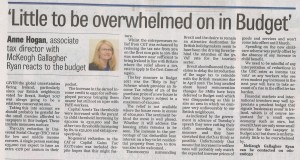Small Mercies
Analysis of Budget 2017
Given the global uncertainties facing Ireland, particularly since our UK neighbours voted for Brexit, Budget 2017 was always going to be a relatively conservative one. Taking this into account we should probably be grateful for the small mercies afforded to taxpayers in this budget. These include measures such as:
- The 0.5% reduction in Universal Social Charge (USC) rates for low and middle income earners. A single person earning €35,000 can expect to have an extra €178 per
 annum in their pocket.
annum in their pocket.
- The increase in the earned income credit to €950 for self-employed persons bringing them nearer but still not on a par with PAYE workers.
- The reduction in the DIRT rate to 39% with the intention of reducing the rate to 33% by 2020.
- CAT thresholds were increased with the parent to child threshold increasing by €30,000 to €310,000 and the other two thresholds increasing by 8% to €32,500 and €16,250 respectively. No general reduction in the CAT or CGT rates was included despite hopes that this might feature. Whilst the Entrepreneurs Relief from CGT was enhanced by reducing the tax rate from 20% on the first €1m gain to 10% this was nowhere near sufficient to bring Ireland in line with the UK where the relief allows a 10% rate to apply to the first £10m of a gain.
The key measure in Budget 2017 was the “Help to Buy” Scheme which provides an Income Tax rebate of 5% of the purchase price of a new house to first time buyers subject to a maximum of €20,000. The relief is not available where the house costs in excess of €600,000. The sentiment behind the move is well placed. Whether it will address the housing crisis remains to be seen. The increase in the percentage of tax deductible loan interest on a buy-to-let residential property from 75% to 80% was also to be welcomed.
The relaxation of the Living City Initiative rules will be useful for Limerick city with the initiative being extended to landlords and the removal of the cap on floor size.
The concerns surrounding Brexit and the desire to remain an attractive destination for UK holidaymakers seem to have been the driving force behind the retention of the 9% VAT rate for the tourism sector. Brexit also influenced the decision to delay the introduction of the sugar tax to coincide with the UK measures due in April 2018. The long awaited share based remuneration changes for SMEs have been deferred to Budget 2018 which was disappointing as this is also an area in which we compare very unfavourably to our UK neighbours.
As indicated by the government in advance of Tuesday’s speech they were cutting their cloth according to their measure and they have stretched that cloth as thinly as possible. Unfortunately that means that increases in welfare rates will probably only match the expected increase prices of goods and services and won’t come into effect until March of next year. Similarly, spending on the new childcare scheme was partly offset by the absence of any increase in child benefit. We need to be mindful of any interpretation of reductions in the USC rates as income tax ‘cuts’ as any workers who see even modest pay increases in the next year will have to take account of a rise in the effective tax burden. Financial markets and international investors may well appreciate a prudent budget that signals ‘business as usual’ in Ireland, which is of course important for a small open economy such as ours, but overall there are only some small mercies for the taxpayer in Budget 2017 but there is unfortunately little to be overwhelmed by.
— This article appeared in the Limerick Leader on 15 October 2016.
